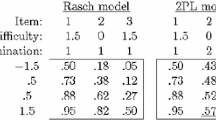Abstract
Synthetic data are used to examine how well axiomatic and numerical conjoint measurement methods, individually and comparatively, recover simple polynomial generators in three dimensions. The study illustrates extensions of numerical conjoint measurement (NCM) to identify and model distributive and dual-distributive, in addition to the usual additive, data structures. It was found that while minimum STRESS was the criterion of fit, another statistic, predictive capability, provided a better diagnosis of the known generating model. That NCM methods were able to better identify generating models conflicts with Krantz and Tversky's assertion that, in general, the direct axiom tests provide a more powerful diagnostic test between alternative composition rules than does evaluation of numerical correspondence. For all methods, dual-distributive models are most difficult to recover, while consistent with past studies, the additive model is the most robust of the fitted models.
Similar content being viewed by others
Reference note
Cattin, P. & Wittink, D. R. A Monte Carlo study of metric and nonmetric estimation methods for multiattribute models (Res. Paper No. 341). Graduate School of Business: Stanford University, 1976.
References
Arbuckle, J. & Larimer, J. The number of two-way tables satisfying certain additivity axioms.Journal of Mathematical Psychology, 1976,13, 89–100.
Cliff, N. Scaling.Annual Review of Psychology, 1973,29, 473–500.
Cohen, H. S. & Jones, L. E. The effects of random error and subsampling of dimensions on recovery of configurations by nonmetric multidimensional scaling.Psychometrika, 1974,39, 69–90.
Coombs, C. H. & Bowen, J. N. A test of VE-theories of risk and the effect of the central limit theorem.Acta Psychologica, 1971,35, 15–28.
Coombs, C. H. & Huang, L. C. Polynomial psychophysics of risk.Journal of Mathematical Psychology, 1970,7, 317–338.
Emery, D. R. DIST: A numerical conjoint measurement program designed to scale data to a distributive model in three dimensions.Journal of Marketing Research, 1977,XIV, 413–414. (a)
Emery, D. R. DULDST: A numerical conjoint measurement program designed to scale data to a dualdistributive model in three dimensions.Journal of Marketing Research, 1977,XIV, 558–559. (b)
Emery, D. R. The diagnostic role of error analysis in discriminating among algebraic models of choice. Unpublished Ph.D. dissertation, The University of Kansas, 1977. (c)
Fischer, G. W. Multidimensional utility models for risky and riskless choice.Organizational Behavior and Human Performance, 1976,17, 127–146.
Green, P. E. On the robustness of multidimensional scaling techniques.Journal of Marketing Research, 1975,12, 73–81.
Green, P. E. & Rao, V. R. Conjoint measurement for quantifying judgmental data.Journal of Marketing Research, 1971,8, 355–363.
Green, P. E. & Srinivasan, V. Conjoint analysis in consumer research: Issues and outlook.Journal of Consumer Research, 1978,5, 103–123.
Green, P. E. & Wind, Y.Multi-attribute decisions in marketing: A measurement approach. Hinsdale, Illinois: The Dryden Press, 1973.
Green, P. E., Wind, Y., & Jain, A. K. Preference measurement of item collections.Journal of Marketing Research, 1972,9, 371–377.
Isaac, P. D. & Poor, D. D. S. On the determination of appropriate dimensionality in data with error.Psychometrika, 1974,39, 91–109.
Krantz, D. H. & Tversky, A. Conjoint measurement analysis of composition rules in psychology.Psychological Review, 1971,78, 151–169.
Krantz, D. H., Luce, R. D., Suppes, P., & Tversky, A.Foundations of Measurement. New York: Academic Press, 1971.
Kruskal, J. B. Analysis of factorial experiments by estimating monotone transformations of the data.Journal of the Royal Statistical Society, Series B, 1965,27, 251–263.
McClelland, G. A note on Arbuckle and Larimer, “The number of two-way tables satisfying certain additivity axioms.”Journal of Mathematical Psychology, 1977,15, 292–295.
Siegel, S.Nonparametric statistics for the social sciences. New York: McGraw-Hill, 1956.
Shepard, R. N. Metric structures in ordinal data.Journal of Mathematical Psychology, 1966,3, 287–315.
Sherman, C. R. Nonmetric multidimensional scaling: A Monte Carlo study of the basic parameters.Psychometrika, 1972,37, 323–355.
Ullrich, J. R. & Cummins, D. E. PCJM: A program for conjoint measurement analysis of polynomial composition rules.Behavioral Science, 1973,18, 226–227.
Ullrich, J. R. & Painter, J. R. A conjoint measurement analysis of human judgment.Organizational Behavior and Human Performance, 1974,12, 50–61.
Wagenaar, W. A. & Padmos, P. Quantitative interpretation of stress in Kruskal's multidimensional scaling technique.British Journal of Mathematical and Statistical Psychology, 1971,24, 101–110.
Wallsten, T. S. Conjoint measurement framework for the study of probabilistic informative processing.Psychological Review, 1972,79, 245–260.
Young, F. W. Nonmetric multidimensional scaling: Recovery of metric information.Psychometrika, 1970,35, 455–473.
Yntema, D. B. & Torgerson, W. S. Man-computer cooperation in decisions requiring common sense.IRE Transactions of the Professional Group on Human Factors in Electronics, 1961,HFE-2(1), 20–26.
Author information
Authors and Affiliations
Additional information
Douglas Emery is now at the Krannert Graduate School of Management, Purdue University, West Lafayette, IN, on leave from the University of Calgary.
Rights and permissions
About this article
Cite this article
Emery, D.R., Hutton Barron, F. Axiomatic and numerical conjoint measurement: An evaluation of diagnostic efficacy. Psychometrika 44, 195–210 (1979). https://doi.org/10.1007/BF02293971
Received:
Revised:
Issue Date:
DOI: https://doi.org/10.1007/BF02293971




